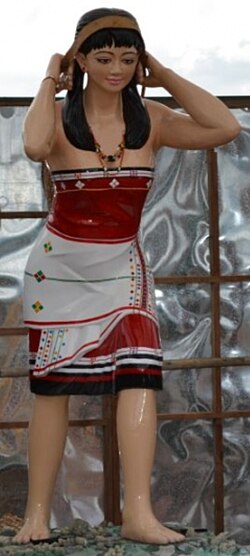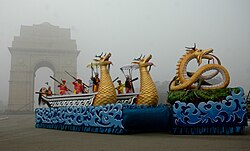Haoreima
| Haoreima | |
|---|---|
Goddess of diseases, illnesses, souls and spirits[1] | |
| Member of Lairembis | |
 Statue of goddess Haoreima in a shrine in the Kakching Garden | |
| Other names | Haoleima, Haoleipi, Haoreibi, Haonupi, Haonubi, Hauleima, Haureima, Hauleipi, Haureibi, Haunupi, Haunubi |
| Affiliation | Meitei mythology (Manipuri mythology) and Meitei religion (Sanamahism) |
| Major cult centre | Kakching |
| Abode | Kakching |
| Artifacts | Basket |
| Symbol | Basket |
| Gender | Female |
| Region | Ancient Kangleipak (Ancient Manipur) |
| Ethnic group | Meitei ethnicity |
| Personal information | |
| Died | |
Template:Infobox Sanamahist term
| Part of a series on |
| Meitei mythology |
|---|
 |
Template:Sanamahism Haoreima (Meitei: ꯍꯥꯎꯔꯩꯃ) or Haoleima (Old Manipuri: ꯍꯥꯎꯂꯩꯃ) (literally, "tribal lady"[2]) is a goddess in Meitei mythology and religion of Ancient Kangleipak (Ancient Manipur).[1][3] She was a woman from the hills, who was killed while arranging to meet her lover, and turned into a tortured spirit. She is regarded as an incarnation of Goddess Panthoibi.[4] She is also identified with goddess Nongthang Leima.[5]
Etymology[edit]
In Meitei language (Manipuri language), the name "Haoreima" is derived from "Haoleima". "Haoleima" is made up of two component words, "Hao" and "Leima".[2] In Meitei language (Manipuri language), "Hao" has multiple meanings. It may mean (1) yes (the response), (2) tasty, savoury or (3) tribe.[6] Here, "Hao" means a "tribe". In Meitei language (Manipuri language), "Leima" means a queen or a mistress or a lady.[7] The name "Haoreima" usually refers to a tribal woman carrying a traditional elongated basket ("sam" or "sham").[2]
Namesakes[edit]
There are many people with the name "Haoreima" in the history of Ancient Kangleipak (Ancient Manipur). Haoreima Tamheibee was the daughter of King Atom Nongyai Thingkol Hanba of the Khuman dynasty.[8][9] She was married to Meitei King Kainou Irengba (984 AD-1074 AD).[10][9] After the marriage, she came to be known as "Meitei Leima" (lit. Meitei Queen).[11][9]
See also[edit]
References[edit]
- ↑ 1.0 1.1 Brahmacharimayum Kulachandra Sharma. চৈথারোল কুমপাপা (in ꯃꯤꯇꯩ ꯂꯣꯟ). p. 603.
- ↑ 2.0 2.1 2.2 Moirangthem Kirti (1988). Religion and Culture of Manipur. Manas Publications. ISBN 978-81-7049-021-0.
- ↑ Memchoubi (1998). Eigee Palem Nungshibee (in ꯃꯤꯇꯩ ꯂꯣꯟ). p. 17.
- ↑ Shekhawat, Seema; Re, Emanuela C. Del (2017-12-18). Women and Borders: Refugees, Migrants and Communities. Bloomsbury Publishing. p. 227. ISBN 978-1-83860-987-0.
- ↑ Brahmacharimayum Kulachandra Sharma. চৈথারোল কুমপাপা (in ꯃꯤꯇꯩ ꯂꯣꯟ). p. 403.
- ↑ "Learners' Manipuri-English dictionary.Hao". uchicago.edu.
- ↑ "Learners' Manipuri-English dictionary.Leima". uchicago.edu.
- ↑ Tensuba, Keerti Chand (1993). Genesis of Indian Tribes: An Approach to the History of Meiteis and Thais. Inter-India Publications. ISBN 978-81-210-0308-7.
- ↑ 9.0 9.1 9.2 Brahmacharimayum Kulachandra Sharma. চৈথারোল কুমপাপা (in ꯃꯤꯇꯩ ꯂꯣꯟ). p. 597.
- ↑ Ray, Asok Kumar; Chakraborty, Satyabrata (2008). Society, Politics, and Development in North East India: Essays in Memory of Dr. Basudeb Datta Ray. Concept Publishing Company. ISBN 978-81-8069-572-8.
- ↑ Devi, L. Kunjeswori (2003). Archaeology in Manipur. Rajesh Publications. ISBN 978-81-85891-18-7.
External links[edit]
- Ibemhal, Thounaojam Chanu (2000). Haoreima Shambubi.
- CS1 foreign language sources (ISO 639-2)
- Abundance deities
- Abundance goddesses
- Beauty deities
- Beauty goddesses
- Crafts deities
- Crafts goddesses
- Death deities
- Death goddesses
- Domestic and hearth deities
- Domestic and hearth goddesses
- Fertility deities
- Fertility goddesses
- Fortune deities
- Fortune goddesses
- Health deities
- Health goddesses
- Leima
- Life-death-rebirth deities
- Life-death-rebirth goddesses
- Love and lust deities
- Love and lust goddesses
- Magic deities
- Magic goddesses
- Maintenance deities
- Maintenance goddesses
- Medicine deities
- Medicine goddesses
- Meitei gods and goddesses
- Mountain deities
- Mountain goddesses
- Names of God in Sanamahism
- Nature deities
- Nature goddesses
- Peace deities
- Peace goddesses
- Time and fate deities
- Time and fate goddesses
- Virgin deities
- Virgin goddesses
- Indian religion stubs
